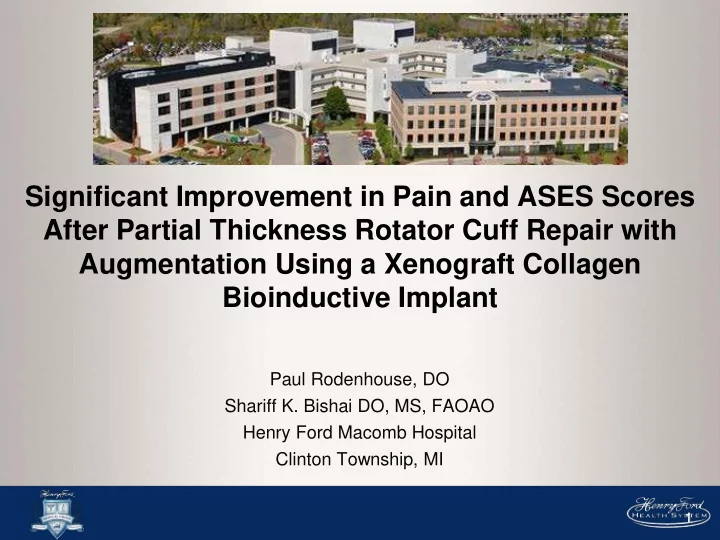

Significant Improvement in Pain and ASES Scores After Partial Thickness Rotator Cuff Repair with Augmentation Using a Xenograft Collagen Bioinductive Implant Paul Rodenhouse, DO Shariff K. Bishai DO, MS, FAOAO Henry Ford Macomb Hospital Clinton Township, MI 1
Disclosure Statement PER: None SKB – Zimmer/Biomet – DePuy – Rotation Medical – Arthrex – Ceterix 2
Introduction Partial thickness rotator cuff tears are common pathology that significantly affect a large spectrum of patients from sedentary individuals to athletes 1 Despite their high prevalence, the diagnosis and treatment remain controversial due to literature focus on full-thickness tears 2 3
Introduction Sher et al reported 20% prevalence of partial-thickness tears on MRI in 96 asymptomatic shoulders 2 Based on cadaveric and imaging studies partial thickness tears range from 13 to 32% with a strong correlation to age 1 Milgrom et al demonstrated linear increase in prevalence after 5th decade of life 3 4
Introduction Conner et al. performed shoulder MRIs of asymptomatic elite overhead athletes showing 40% had partial or full-thickness tears 1 This demonstrates no age group or population is immune 5
Etiology Intrinsic factors: hypocellularity, fascicular thinning, granulation tissue, and decreased vascularity of tissue predispose tendon to degenerative tearing 1 Extrinsic factors: subacromial impingement, glenohumeral instability, internal impingement 1 Traumatic events: singular or repetitive 1 These lead to tensile overload a tendon fiber failure 6
Etiology Increases in tendon strain due to presence of a tear lead to propagation and increases in tear size over time 2-4 Often progress to full-thickness tears 4 One study of 40 patients with partial thickness cuff tears followed for a mean of 13.5 months showed 80% of lesions to have enlarged or progressed to full-thickness lesions 4 7
Treatments Many treatments for partial thickness tears including: – Arthroscopic debridement – Conversion to full thickness and repair – In-situ transtendon repairs. All have shown some benefit in certain patients in a multitude of studies, however no technique has set itself apart from the rest 8
Treatments A novel technique, Arthroscopic augmentation with a xenograft collagen implant Picture Courtesy of Rotation Medical 9
Research A finite-element study demonstrated by increasing thickness of the bursal side of supraspinatus by 2mm can decrease intra-tendinous strain by 47% in bursal sided tears and 40% on articular sided tears 4 10
Research The implant decreases local tendon strain and provides a scaffold for new tendon tissue to grow Boker et al showed a mean increase in tendon thickness of 2.2mm at 3 months post-op which persisted for 24 months and was indistinguishable from normal cuff tissue by MRI 4 11
Research Arnoczky et al, Arthroscopy 2016 – Biopsy of collagen implants retrieved from 7 patients on second look arthroscopies Cellular incorporation Tissue formation and maturation Implant resorption Biocompatibility to that of normal rotator cuff. 12
Study 75 patients October 2014- March 2017 Single Surgeon All patients had rotator cuff tears measuring 50% or less on MRI and confirmed intra- operatively by surgeon All failed conservative treatment: corticosteroid injections, oral anti-inflammatories, activity modifications, and physical therapy 13
Study Exclusion criteria included revision procedures as well as the use of suture anchors in fixation VAS and ASES were patient reported in office 14
VAS Results 7 5.25 3.5 1.75 0 Pre-op Day 1 2 Weeks 6 weeks 3 months 6 months 6.03 4.61 2.94 3.05 2.70 2.08 15
ASES Results 87.5 70 52.5 35 17.5 0 Pre-op 6 weeks 3 months 6 months 35.49 46.18 61.74 69.49 16
Surgeons Post-op Protocols Repair with Augmentation - Start PT ASAP - Out of sling ASAP Traditional Anchor Repair - 6 weeks in Sling - PT @ 4 Weeks - PROM 4-6 Weeks - AAROM 4-8 Weeks - AROM 8 Weeks 17
Conclusion These studies show that the xenograft collagen implant is a viable treatment option for patients with partial thickness rotator cuff tears and provides pain relief and functional improvement 18
References 1. Matthewson, Graeme. "Advances in Orthopedics." Partial Thickness Rotator Cuff Tears: Current Concepts 2015 (2015): n. pag. Web. 2. R.P. Finnan and L.A. Crosby, “Partial thickness rotator cuff tears, “ Journal of Shoulder and Elbow Surgery , vol. 19, no.4, pp. 609-616, 2010. 3. C. Milgrom, M. Schaffler, S. Gilbert, and M. Van Holsbeeck “Rotator-cuff changes in asymptomatic adults. The effect of age, hand dominance, and gender,” The Journal of Bone and Joint Surgery- British Volume, vol. 77, no. 2, pp.296-298, 1995. 4. D. Boker, D. Sonnabend, L. Deady, B. Cass, A. Young, C. Van Kampen, S. Arnoczky “Evidence of healing of partial thickness rotator cuff tears following arthroscopic augmentation with a collagen implant: 2-year MRI follow-up,” Muscles, Ligaments, and Tendons Journal, 2016;6 (1): 16-25 19
Thank You 20
Recommend
More recommend